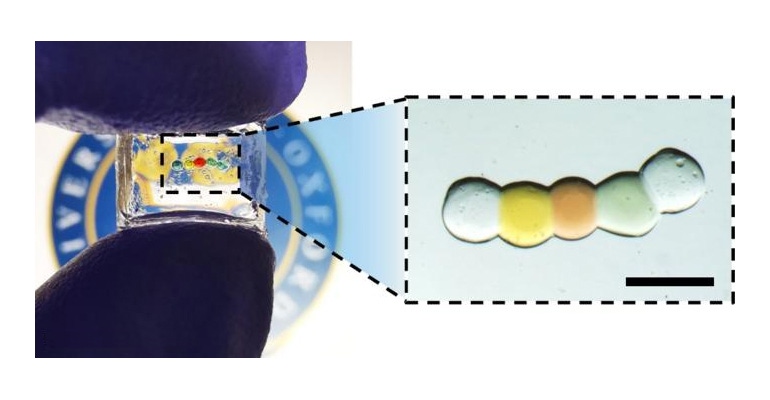Droplet Battery Holds Promise for Miniaturized Bio-Integrated Devices
Oxford researchers have developed a tiny battery that could be used to power minuscule devices integrated into human tissues.

Researchers at the University of Oxford in the United Kingdom have achieved a significant milestone in developing tiny bio-integrated devices capable of directly stimulating cells. Their work, published in the journal Nature, opens up potential therapeutic applications such as targeted drug delivery and enhanced wound healing. These bio-integrated devices require a power source, which has been a challenge at the microscale level until now.
To address this challenge, Oxford's Department of Chemistry researchers created a miniaturized power source inspired by how electric eels generate electricity. The device utilizes internal ion gradients within a chain of five nanolitre-sized droplets of a conductive hydrogel. Each droplet has a different composition, creating a salt concentration gradient across the chain. Lipid bilayers separate the droplets, providing mechanical support while preventing ion flow between them.
Activating the power source involves cooling it to 4°C and changing the surrounding medium, causing the droplets to form a continuous hydrogel, enabling ion flow from high-salt droplets at the ends to the low-salt droplet in the middle. By connecting electrodes to the end droplets, the ion gradients' energy is converted into electricity, making the hydrogel structure a power source for external components.
During the study, the activated droplet power source generated a continuous current lasting over 30 minutes. A unit composed of 50 nanolitre droplets produced a maximum output power of approximately 65 nanowatts (nW) and maintained a similar current level even after 36 hours of storage.

The researchers demonstrated how living cells could be attached to one end of the device, allowing their activity to be regulated by the ionic current. They attached the device to droplets containing human neural progenitor cells, which were marked with a fluorescent dye to track their activity. When the power source was activated, time-lapse recording showed waves of intercellular calcium signaling in the neurons, driven by the local ionic current. This calcium signaling is a vital mechanism for neurons to communicate and coordinate various biological activities.
Dr Yujia Zhang (Department of Chemistry, University of Oxford), the lead researcher for the study, stated: “The miniaturized soft power source represents a breakthrough in bio-integrated devices. By harnessing ion gradients, we have developed a miniature, biocompatible system for regulating cells and tissues on the microscale, which opens up a wide range of potential applications in biology and medicine.”
The researchers suggest that the device's modular design offers the flexibility to combine multiple units, increasing the generated voltage and current. This potential has significant implications for various applications, including next-generation wearable devices, bio-hybrid interfaces, implants, synthetic tissues, and microrobots. To demonstrate this, they connected 20 five-droplet units in a series, effectively powering a light-emitting diode, which typically requires around 2 Volts. They envision automating the production process, potentially using a droplet printer, to create extensive networks of droplet power units, numbering in the thousands.
Professor Hagan Bayley (Department of Chemistry, University of Oxford), the research group leader for the study, stated: “This work addresses the important question of how stimulation produced by soft, biocompatible devices can be coupled with living cells. The potential impact on devices including bio-hybrid interfaces, implants, and microrobots is substantial.”
About the Author(s)
You May Also Like





